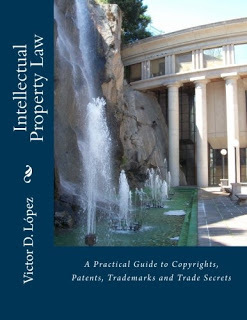Copyright chapter excerpt from Intellectual Property Law: A Practical Guide to Copyrights, Patents, Trademarks and Trade Secrets
Copyright chapter excerpt from
Intellectual Property Law: A Practical Guide to Copyrights, Patents, Trademarks and Trade Secrets
Subject Matter of CopyrightThe subject matter covered by the law of copyright is rather broad and includes “original works of authorship fixed in any tangible medium of expression, now known or later developed, from which they can be perceived, reproduced, or otherwise communicated, either directly or with the aid of a machine or device.” Copyright protection attaches to original works of authorship fixed in a permanent medium. Note that an original work of authorship is not protected as soon as it is created; rather protection attaches when it is fixed onto a permanent medium so that it can be reproduced and perceived by others at a later time. It is not the act of creation but rather the act of saving or archiving one’s creation in a tangible medium that grants copyright protection to the creator. For example, if a poet constructs a new poem and speaks it aloud, no copyright attaches to this new creation. It is only when the work is fixed in an existing or yet to be invented “tangible medium of expression” that can cause it to be reproduced and perceived by others later. Writing the poem on paper with a pen or pencil will suffice, as would recording a reading of the poem on tape or in digital form saved as an audio or video file on a computer, compact disk or DVD. Likewise, a new dance that is created by a choreographer is not copyrighted until it is “saved” in some form such as by being videotaped or by the choreographer writing down the steps in the dance on paper or some other permanent form through which the dance steps could later be communicated by others. Thus, a photographer who snaps a photograph automatically obtains a copyright to it when the image is captured on film or saved in digital form to the camera’s internal memory, or in an external SD card or other removable storage. And a writer’s words are copyrighted as soon as they are transferred to paper by a pen or other writing implement, or saved onto a computer’s hard disk or removable storage (e.g., burned onto a CD or DVD or saved onto a USB thumb drive or other removable storage media).
Subject Matter of CopyrightThe subject matter covered by the law of copyright is rather broad and includes “original works of authorship fixed in any tangible medium of expression, now known or later developed, from which they can be perceived, reproduced, or otherwise communicated, either directly or with the aid of a machine or device.” Copyright protection attaches to original works of authorship fixed in a permanent medium. Note that an original work of authorship is not protected as soon as it is created; rather protection attaches when it is fixed onto a permanent medium so that it can be reproduced and perceived by others at a later time. It is not the act of creation but rather the act of saving or archiving one’s creation in a tangible medium that grants copyright protection to the creator. For example, if a poet constructs a new poem and speaks it aloud, no copyright attaches to this new creation. It is only when the work is fixed in an existing or yet to be invented “tangible medium of expression” that can cause it to be reproduced and perceived by others later. Writing the poem on paper with a pen or pencil will suffice, as would recording a reading of the poem on tape or in digital form saved as an audio or video file on a computer, compact disk or DVD. Likewise, a new dance that is created by a choreographer is not copyrighted until it is “saved” in some form such as by being videotaped or by the choreographer writing down the steps in the dance on paper or some other permanent form through which the dance steps could later be communicated by others. Thus, a photographer who snaps a photograph automatically obtains a copyright to it when the image is captured on film or saved in digital form to the camera’s internal memory, or in an external SD card or other removable storage. And a writer’s words are copyrighted as soon as they are transferred to paper by a pen or other writing implement, or saved onto a computer’s hard disk or removable storage (e.g., burned onto a CD or DVD or saved onto a USB thumb drive or other removable storage media).

Published on May 15, 2017 14:18
No comments have been added yet.
Victor D. Lopez
My blogs reflects my eclectic interests and covers a wide range of areas, including writing, law, politics, issues of public interest, ethics, and samples of my published work (especially fiction and
My blogs reflects my eclectic interests and covers a wide range of areas, including writing, law, politics, issues of public interest, ethics, and samples of my published work (especially fiction and poetry). Blog feeds by general subject areas can be accessed from my web page at http://www.victordlopez.com.
...more
- Victor D. López's profile
- 11 followers



